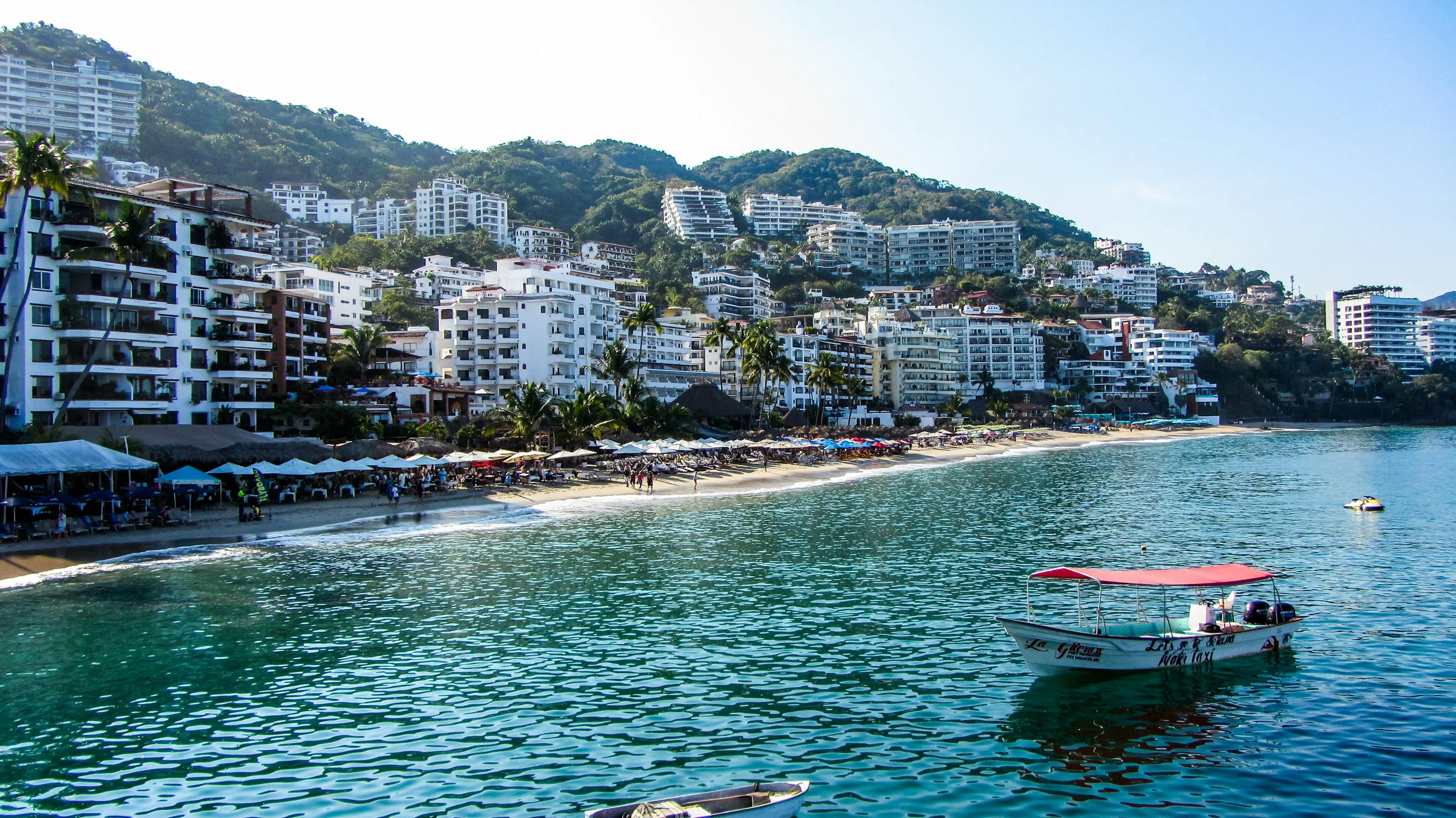By Don Murray
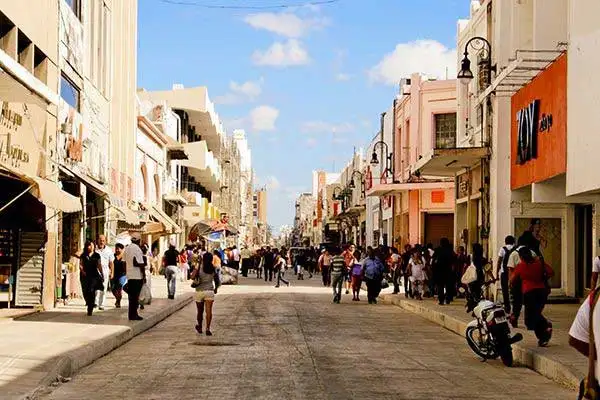
Near the northern coast of Mexico’s Yucatan Peninsula, about 22 miles south of the Gulf of Mexico, lies the regal colonial city of Merida. This beautiful, vibrant city of some one million people offers culture, sports, modern infrastructure, world-class affordable medical care, and handy access to the Gulf of Mexico. It’s easy to understand why Merida has long been a favorite of expats. It is also among the most historically significant cities in all of Mexico.
Capital of the state of Yucatan, Merida’s ancient roots go back to, what was formerly, the Maya city of Tho´, also known as Ichkaanziho´. And it is Merida’s rich history and current indigenous influences, mixed with a modern lifestyle, up-to-date infrastructure, and a reduced cost of living that has attracted large numbers of expats.
Appreciation for Merida, its rich cultural heritage, and gorgeous architecture, often comes from understanding its painful history. Merida endured a significant amount of trauma before emerging as it has.
Though bravely battling against an overwhelming Spanish force of Conquistadors armed with broadswords, various gunpowder weapons, and shielded with metallic armor, Tho´s Maya warriors were outmatched against their invaders. With only wooden clubs, cotton padding on their bodies, and using crude spears and flint-tipped arrows, the fierce Maya men fought and died trying to repel the invaders. They eventually lost the protracted battle and the city of Tho´ fell to the Conquistadors in 1540 and was renamed Merida after a favored city in Spain.
But the fighting continued for another two centuries as the Maya resented being invaded and enslaved. In fact, not only did the Spanish want to extract all the wealth from Mexico and its people, but they were also under orders of the catholic church to destroy sacred Maya temples and build catholic churches to convert the indigenous people to Catholicism.
Grand temples as well as shrines and other Maya structures were deconstructed using enslaved Maya labor. The Conquistadors then ordered that the enormous carved stones were to be used to construct Catholic churches and other public buildings and some large residences that still stand today in Merida’s central historic district. The Maya carvings on the stones are clearly visible. These architectural shrines to ancient history provide a breathtaking backdrop to the city.
Merida is believed, by many historians, to be the oldest continually occupied city in the Americas. It is a stunningly beautiful city, its rich history on display through its architecture and the strong indigenous influence of its people.
The delicious regional food competes with the architecture for your attention and one cannot look at any building in the large historic district without being forced to feel something about the way that this city and all colonial cities came to be.
Get Your Free Mexico Report Today!
Get Your Free Mexico Report Today!
Learn more about Mexico and other countries in our daily postcard e-letter. Simply enter your email address below and we’ll send you a free special report – Mexico: The Perfect Close-to-Home Retirement Haven.

By submitting your email address, you will receive a free subscription to IL Postcards and special offers from International Living and our affiliates. You can unsubscribe at any time, and we encourage you to read more about our Privacy Policy.
Retire in Merida
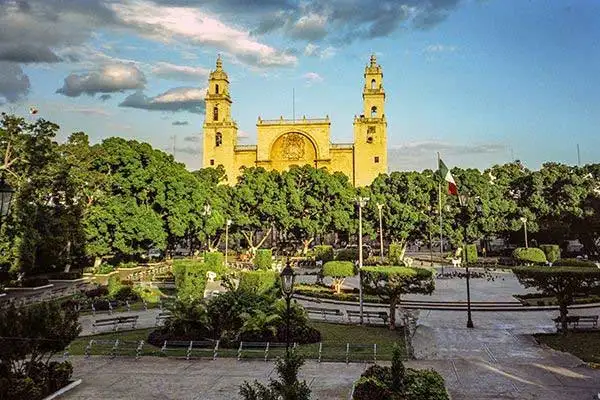
While no city has it all, Merida comes pretty close. For expats leaving the first-world comforts of the USA, Merida will provide an easy transition when compared to many other options.
First, high-speed internet is readily available throughout most of the city and offered by several providers. Coming and going from Merida is a snap with freeways and highways connecting to the Riviera Maya on the Caribbean coast as well as connecting to a good highway system throughout Mexico. And of course, there is a modern International Airport which makes airline travel readily accessible.
Shopping is an essential part of life as we all need food, clothing, and having a good wine in the refrigerator is always a good thing. Merida offers a plethora of shopping options from large open markets to small shops, strip malls, street vendors, and big box stores. It’s all here.
Mexico offers an easily obtainable retirement visa, providing for quick, permanent residency for those meeting the simple qualifications. The straightforward process begins at the Mexican consulate in your home state. There, the consulate officer will verify your income based on the documents you provide, review a nominal number of other documents and your completed application. After a short interview, if approved, you’ll likely depart with your permanent residency visa affixed to the inside of your passport.
All legal residents over the age of 60 qualify for a discount card from INAPAM (Instituto Nacional para las Personas Adultas Mayores) facilitating discounts on a wide variety of goods and services.
Public transportation is available throughout the city by utilizing a combination of taxis, buses, and small vans called colectivos. Prices are geared toward the local population and are more than reasonable—cheap in fact. Bus and colectivo fares run from 25 cents to 60 cents.
Medical care is some of the best in the world with many doctors speaking English and modern hospitals to provide for any surgery needs. And it’s affordable by participating in one of two national health care programs; either Seguro Popular or the IMSS program. In fact, it is cheap enough to simply pay for routine doctor visits and prescriptions out-of-pocket with hardly a bump to your budget. Nearly all medications can be purchased directly from the pharmacy without a prescription (narcotics and strong antibiotics are obvious exceptions) and cost only a fraction of prices north of the border.Merida has a significant population of expats. Both the U.S. and Canada are well represented as well as many countries from Europe and Asia. Facebook hosts a number of expat groups for Merida.
Lifestyle in Merida
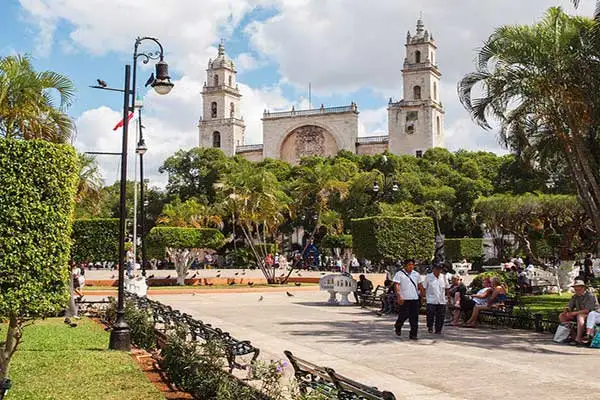
Those who live in Merida enjoy warm weather year round. In fact, the one complaint that could be made about the weather is that it can get hot…really hot. Some summer days can hover above 95 degrees Fahrenheit so the air conditioning in homes and cars is common as are small plunge pools for your home.
Merida is a city chock full of culture. There are seven institutions of higher learning to include traditional universities, colleges, and technical schools. There are eight or ten museums displaying a variety of items to include traditional and indigenous items.
Often called the White City for the number of colonial structures, all painted white, Merida is a city that loves its art and artists. Hosting around seven or eight active galleries, Merida even has one entire street devoted to original sculptures, the Paseo de Montejo. Each year, the city installs one new original piece from a local artist along with an additional piece from an artist from another country.
Merida is home to the Yucatan Symphony Orchestra. Music lovers can enjoy traditional classical performances along with Jazz and Opera performed at one of the six active theaters.
Expats seeking books in English will be thrilled with the Merida English Library. Not only a resource for thousands of English books, the library also serves as a hub for expats to mix and mingle and often assists with the organization of meetings and functions.
And speaking of language, the Spanish spoken in Merida and the rest of the Yucatan Peninsula, is different from the Spanish spoken in the rest of Mexico. Yucatan Spanish retains a heavy Maya influence, both in the sound and rhythm of speech, as well as the definition of some words and phrases. As the Yucatan Peninsula is separated from the rest of Mexico, the normal blending and melding of a language, without such isolation, has not occurred as it has throughout the rest of Mexico.
Cost of Living in Merida

Like all of Mexico, Merida offers a reduced cost of living when compared to most places, north of the border. This is explained by low labor costs as well as reduced costs for materials and essentials. Due to the low wages, the market will simply not bear the sort of profits normally built into goods and services, north of the border.
Whether you rent or buy, housing costs are affordable for almost every budget. The singular exception may be related to purchasing and restoring one of the many colonial homes available for restoration. While their prices are very reasonable, the cost of the refurbishment may quickly reduce your bank account. That said, many expats have enjoyed taking on that challenge with great results.
Below is an example of a monthly budget for a couple living in Merida:
| Rent three-bedroom apartment (Downtown) | $550 to $850 |
| Utilities (Electricity, Water, Gas) | $60 |
| Internet High Speed DSL Unlimited | $24 to $30 |
| Food/Groceries | $350 |
| Transportation | $100 |
| Entertainment | $250 |
| Medical | $100 |
| Total | $1,434 to $1,740 |
Get Your Free Mexico Report Today!
Get Your Free Mexico Report Today!
Learn more about Mexico and other countries in our daily postcard e-letter. Simply enter your email address below and we’ll send you a free special report – Mexico: The Perfect Close-to-Home Retirement Haven.

By submitting your email address, you will receive a free subscription to IL Postcards and special offers from International Living and our affiliates. You can unsubscribe at any time, and we encourage you to read more about our Privacy Policy.
Colonial Swagger and Warm Evening Breezes in the Yucatán’s Most Sophisticated City
By Sean Keenan
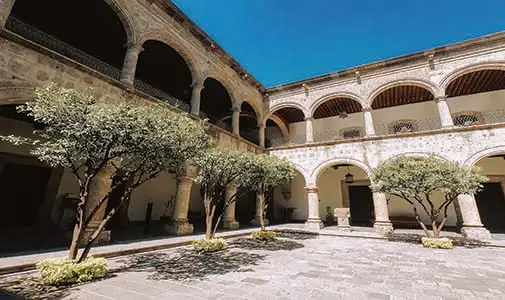
I left my camera at an ice-cream stall. My sunglasses chose to remain on a bench in a bus station. Credit cards? They slipped from my pocket and made a break for the raked gravel of a breakfast terrace. My hat remained in a colectivo taxi while I explored a cenote. And while I strolled the city streets, my phone made itself at home in the English Library of Mérida.
It speaks volumes for the character of Mexico’s people that I got every one of those items back. Every single one.
It also speaks volumes about the sunbaked status of my brain that I managed to mislay so many critical bits and pieces. Temperatures of 116 F change everything, including the concept of value. I could have managed without the camera or phone, but an hour without the hat and I would have needed a hospital.
It’s not always so hot in the Yucatán—I turned up in the middle of a 50-year heatwave. For two days of my trip I was in the hottest place on the planet. And you know what? It’s a lot nicer than being cold.
Locals told me tantalizing stories of the Mérida winter, when the mercury stays fixed around 60 F and you need a light jacket to go out at night. The more excitable residents might even wear gloves. Still, the urban lifestyle here is more adapted to heat than cool. Beers are delivered to your table in an ice bucket, hammocks are strung on the shady side of the courtyard, homeowners draw heavy Andalusian-style shutters over the windows until dusk.
As long as you work with it rather than against it (plan any strenuous activity for the hours before 10 a.m. and stay hydrated and sun-blocked during the day) the heat is magnificent. Like a mild sauna, it works its way bone-deep, relaxes the muscles, soothes the joints, and leaves your skin aglow.Sophisticated bars, galleries, and live theater.If your ideal climate is the spring-like zone between 55 F and 65 F, then cross the Yucatán off your relocation shortlist now. Head to Cuenca in Ecuador, Medellín in Colombia, or Grecia in Costa Rica instead. There’s no point in being uncomfortable if you don’t need to be. But if your spirit animal is a salamander; if you love the throb of the city and a social scene that involves sophisticated bars, galleries, and live theater; nibbling aperitivos at terrace restaurants in Spanish-style plazas while silky warm evening breezes caress your skin; or diving into edgy little cantinas for a shot of mescal, then Mérida is your sultry playground. I won’t mince words—I adored the place.
“Sísal and the Gulf Coast is where the smart money is going now,” Seán Hennessy explains. “We’re 40 minutes from the sea here in Mérida. For people from Canada and the U.S., that’s nothing. It’s like a trip to the store.” Seán’s a long-term Mérida expat who, like everyone else here, has his finger on the pulse of the property market in the region.
His is the name on the outside wall of the place we meet—Hennessy’s Bar on Paseo de Montejo. It’s an Irish pub of impeccable character, without the cliché fripperies such as bicycles mounted on the wall or teapots hanging from the rafters. In fact, the double-height ceilings, billiard room, and dark wood paneling could have come directly from one of Dublin’s finest Georgian townhouses.
Restorations of colonial buildings are a recurring theme in Mérida, with new life being breathed into the city’s handsome architectural legacy by sympathetic architects and their far-sighted patrons. Hennessy’s is a job done very well indeed, and it also happens to be Mérida’s first-choice watering hole for thirsty expats.
I’m drinking the local Indio beer, which bears an uncanny similarity to a red ale from Ireland, although the coincidence is purely that. Seán and his husband, Colm Cooney, are educating me on the many highlights of the city. “Mérida’s become the place for architects to show off,” Colm says. “Young, up-and-coming ones, developing their reputations. You see a lot of fusion; modern flourishes mixed with the colonial style. Some of them are incredible.”
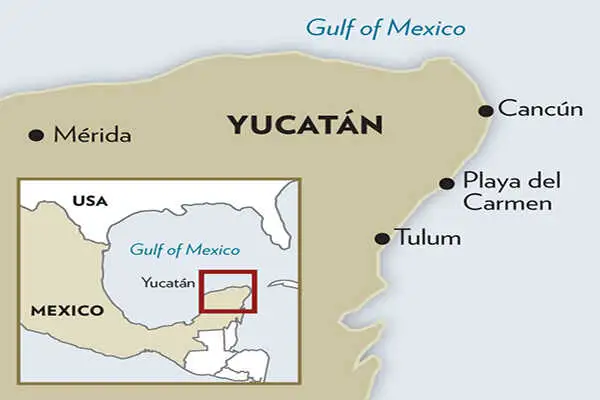
I could happily fritter a month in Mérida, just strolling from shaded plaza to leafy park, stopping off for a chelada at whichever of the outdoor watering holes took my fancy. You could spend a long time doing that here, wandering from the high-end garden terraces of Paseo de Montejo with their tasteful white furniture, overhanging ferns, and ambient world music, then ambling along to the restaurant terraces of Plaza Montejo, where live jazz acts compete with the chime of church bells. Alternatively, I’d happily rough it with a taco from one of the street food kiosks on Parque Eulogio Rosado.
I especially liked that last place—I’d describe it as buzzing with the sound of conversation and civic hubbub except that, in truth, you can’t hear much over the shrieks and whoops of the long-tailed grackles that roost in the square’s canopy of trees. If I were to grow tired of the noise, Mérida’s English Library on Calle 53 is a pocket of calm. Tucked into a quiet residential street, the library is home to over 77,000 items; mostly books, but DVDs are also available to borrow. It’s a lovely spot: high ceilings, packed wooden bookshelves, cool tiled floors, and houseplants on every available surface.
An English-language library of that size tells you just how extensive the expat community of Mérida is. One estimate puts the population of Canadians in the city at 20,000. And that’s just the Canadians— many of whom take advantage of a non-stop Toronto-Mérida route served by WestJet. As David deCoeur, a “60-ish” expat who splits his time between both cities tells me, “I can be door-to-door in seven hours.”
David and his wife, Jayne McMahon, fit the profile of Mérida expats perfectly. Like a lot of transplants here, they’d originally been drawn to the Caribbean coast. In their case, Isla Mujeres was the spot they first fixed upon. But Isla Mujeres, for all its tropical beach beauty, is a one-horse town on an island that’s only a squeak larger than New York’s Central Park. Mérida’s artistic, cosmopolitan sophistication kept calling.
How “Green Gold” Built a City
When we think of Mexico, it’s not long before images of tequila or mescal come to mind. But back when those high-proof products of the agave plant were no more than gulping hooch for tired agricultural laborers, fortunes were being made in Mérida from the tough fibers of the henequén plant, agave fourcroydes. It made the best rope available in the era before petrochemicals, but grew only in the Mérida region. As a result, profits were vast, and on a scale that allowed merchants in this “green gold” to build homes, guilds, and offices in an exuberant, grandiose style.
Most of what’s on display in the historical district of Mérida dates to the 18th and 19th centuries, when the city was at its most prosperous, but the Spanish colonial era in Latin America spanned some 500 years. There’s a lot of variation packed into that half-millenium, and it’s all on display in Mérida. The city’s historic buildings range from its 16th-century stone cathedral through to the organic, arabesque lines of Art Nouveau townhouses.
Too much architecture talk will bore even the most patient of readers, but the point is that in the colonial era, wealthy merchants expected their houses to act as social hubs and material proof of their business acumen—as well as being homes. That gave rise to a focus on beauty and display which we might consider ostentatious today.
Whether they were motivated by civic pride, a desire for controlled beauty, or a wish to impose cultural dominance by reproducing Spanish fashions in the wilds of Mexico is a matter of opinion. Regardless, Mérida is blessed with a large old-town center full of notable—sometimes frivolous, sometimes austere—buildings.
It’s a tonic to walk around such exuberant surroundings. Even more so when you come across a newly restored example, painted in the acid-bright colors synonymous with Mexican décor. Tangerine, baby-blue, scarlet; in higher latitudes, the effect would be hideous. Here, with intense sunlight bleaching every vista with glare, they look magnificent.
After Quebec, it’s the second-safest city in the Americas.“It’s so cultural,” Jayne points out. “Every evening, there’s some sort of entertainment going on. Dance, demonstrations, video-mapping projections in the Plaza Central. That’s before you even consider exhibition launches in the galleries, or readings and events. But the really important thing is that you can enjoy it all because it’s so safe. I can walk around at one o’clock in the morning and not feel threatened.”
Safety is a recurring subject. Mérida’s expats are justifiably proud of the 2019 CEOWorld survey that ranked the city second-safest in the Americas (beaten only by Quebec City, Canada). They’ll quote that to you within the first few minutes of meeting, but they’re quite right to do so. Anecdotal evidence supports the claim, and it’s not just an expat thing. Many wealthy Mexicans keep a home in Mérida, and have their children educated in the city. That’s mainly due to its enviable safety record. I’m still agog at walking past a $200,000 Porsche Carrera casually parked on a residential street in the northeast of town. Not a single guard or security camera was watching over it. You can read all the CEOWorld surveys you like, but actions speak louder than words. I can’t think of many cities with almost 1 million inhabitants where you could simply lock and leave your supercar on a sidestreet (and still expect to find it when you returned).
That’s partly due to investment in police—who are visible everywhere in the centro district—but it’s mainly to do with the city’s long-established prosperity. Prior to the pandemic, Mérida’s unemployment rate was zero. The local government made grants available to entrepreneurs, supported the tourism industry, and in the seven years leading up to 2019 the average tourist stay jumped from 1.5 nights to 3.5.
That’s a phenomenal spike. It’s enough to fuel the sense of excitement that I’ve already picked up on in conversations with expats and locals alike. A sense that paths are converging on Mérida and its surrounds, and that they will bring yet another wave of prosperity to the region.Just $500 a year in property tax.In Mérida itself, property values are respectable, and steady. Both Séan and Colm, and David and Jayne, paid in the region of $180,000 for their two-bedroom homes. The properties are in different parts of the city, and are different styles, so comparing the two isn’t worthwhile. However, it does give an indication of what your money buys. David and Jayne’s covers 2,200 square-feet and has, according to David, “a fair-sized pool.” More importantly, perhaps, is that they pay just $500 a year in property tax.
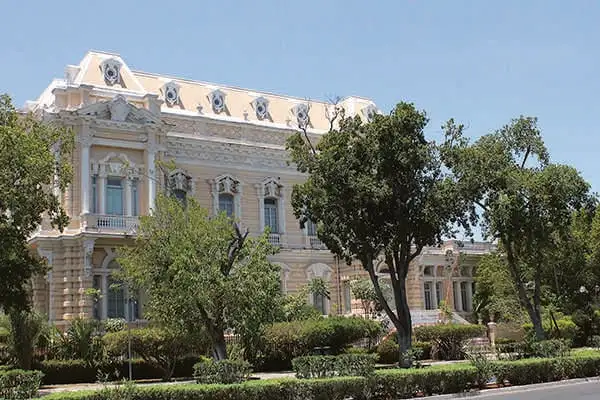
Mérida’s most interesting property picks are colonial buildings in the old town. They’re complex propositions, though, more suited to personal projects than investment purposes. That said, browsing through real estate listings, and talking to expats who have done it, a rule of thumb is that a decent restoration will double the selling price of a neglected property. Done well, that’s a viable business model. If you want to skip the headaches and purchase a finished product, a move-in ready townhouse, perhaps with a small pool and enclosed courtyard, they would start around the $400,ooo mark.
Regardless of whether it’s for investment or for personal use, restoring a colonial home in Mérida is probably best left to experienced expats, the type who are confident with project management and local working arrangements. The rewards, though, are huge: Rescue a neglected gem of a building, restore it over time, and end up living in palatial luxury for a (comparatively) bargain price.
Or, to put it another way, it’s an opportunity to own a Park Avenue-style mansion for under half a million. That’s compelling, but it’s a niche market. Which is why property investors are looking toward yet another overlooked advantage that Mérida holds—white-sand, warm-water beaches within an hour’s drive.
In contrast to the beach towns of the Yucatán’s Caribbean seabord, the Gulf Coast towns of Sísal, Chelem, and Progreso are relatively undiscovered. Squint a little, add a dash of imagination, and you could be looking at Tulum or Playa del Carmen from 30 years ago. Progreso is the primary choice for weekend beach jaunts from Mérida. It’s where most of the city ends up every summer, by tradition. All those grand family mansions that were funded by the henequén trade (see sidebar, page 17) owe their existence to Progreso, the closest port to the city.
The town is now a regular stopping point with international cruise ships, although its atmosphere is still decidedly Mexican. Palapa bars, salsatecas, and rows of foosball machines pull large weekend crowds, alongside a diminutive Ferris wheel at the waterside fairground that might have come from a 1950s movie set on Coney Island. It’s definitely not an internationalized Vegas-on-Sea experience like the Hotel Zone in Cancún, but it’s a fun 20-minute bolt to the sea from Mérida.
Sísal, farther west, is another coastal getaway close to the city. At present, the journey is a little trickier, involving a bottleneck at the market town of Hunucmá, but the pay-off for that is that the road goes past The Butcher Master—renowned locally for its rib-eyes and T-bones. Even with a stop-off for beef, the journey takes less than 45 minutes by car. It’s well worth the trip—Sísal’s beaches are powder-perfect, its mangrove lagoon is bursting with wildlife, and its main street and plaza are heartwarmingly folksy. Much of the area around the village is protected wetland. Ask around the port for Quique Mex—the highly knowledgeable guide with Ziz-Ha Ecotourismo—for a tour, boat trip, or dive excursion. Or just kick back with a cold beer at Zurdo’s palapa bar on the lagoon and watch the tide roll in before heading back to Mérida. Barefoot chic to metropolitan polish in under an hour. Just remember—it’s hot. Don’t lose your hat.
Mérida Practicalities
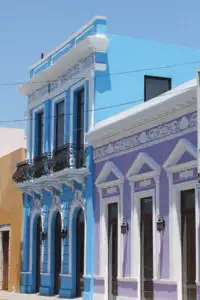
Stay: I’m not a fan of huge chain hotels, even if it means I have to skimp on a little luxury. In a city, I’d rather be in a small place, close to the action. In Mérida, I chose the Villa Orquídea Boutique Hotel on the corner of Calles 52 and 55. It’s about five blocks east of the city’s main plaza, in a beautifully restored, 19th-century townhouse. With a tiny plunge pool, freshly cooked breakfast served at a shared, 15-foot-long formal dining table, and just seven rooms, it had that always-elusive atmosphere of a home-from-home. With double rooms starting at $80, it won’t hit you in the pocketbook either. Be aware that it’s situated in a slightly scruffy part of the city. That doesn’t mean that it’s dangerous, just that it’s not as pretty as the gentrified parts of town. Nevertheless, I loved it.
Eat: Mérida’s culinary tradition is firmly local to the Yucatán region, which in practice means that you’ll be served avocado with just about everything. Beyond that, though, it’s worth abandoning any preconceived notions you might have about Mexican food. Forget chili con carne, burritos, and chimichangas—those are Tex-Mex specialties which are rare here. Instead, tuck into cochinita al pibil, which is pulled pork marinated in sour orange juice and slow-roasted in banana leaves. Or papadzules—soft tortilla wraps containing chopped hard-boiled egg, tomatoes, and cilantro, smothered in a smooth sauce made from pumpkin seeds. (It’s a handy vegetarian option, although I must admit that I found it a touch bland.) Do try sopa de lima though. The name means “lime soup,” although that’s a little bit of a misnomer. There’s a slice of lime floating on top, but it’s actually a hearty chicken, tomato, and cilantro broth. Very refreshing.
Three good places to try the local fare are La Chaya Maya on Calle 55, for a semi-formal evening meal with gloriously kitsch décor and a historical setting. If you’re not feeling grandiose, though, you can enjoy many of the same dishes in the small-but-popular restaurant El Trapiche, on Calle 62, less than a block north of the Plaza Principal. The presentation isn’t quite as elaborate as in La Chaya Maya, but the food is just as good, and half the price. One more option is Mercado 60, on Calle 60. It’s a food hall where you can try various styles of “street food” in a setting akin to a U.S. mall’s food court. That said, there’s genuine street food on any number of streets around the city. Filled tacos go for less than a dollar each, and are good.
Although it’s not in Mérida, I can’t write about food in the region without giving special mention to El Comanche in the beach town of Sísal, some 30 miles northwest of Mérida. At 100 pesos (about $5), their ceviche is among the best plates of food I’ve had anywhere. Sliced grouper fillet, marinated in lime, mixed in with sliced red onion, chopped ripe tomato, and fresh cilantro; it’s a winner.Drink: Go local with a chelada. Weird though it sounds, the mix of cold beer, ice, and lime juice, served in a pint glass with a salted rim, is excellent. It cools the body, quenches the thirst, and replenishes salt lost due to sweating. And it has beer in it, to boot. Be aware that you’ll often be charged for the chelada part separately to the beer. It’s usually less than a dollar, but it explains why your bill has two items on it when you only had one drink. Despite initial misgivings, I loved cheladas. I also tried the sister drink—michelada—which includes tomato juice. I didn’t opt for a second one.
Where though, for a glass of something to take the edge off? I won’t lie, I loved Hennessy’s Bar on Paseo de Montejo. It was as lively an expat hangout as I’ve come across, but even if it weren’t for the chatty folks there, it’s worth checking it out just to see how well the elegant colonial buildings of Mérida’s showpiece boulevard can look with a little loving care (and, admittedly, a sizable restoration budget and a good architect). It’s spacious and air conditioned, with a menu of hearty Irish dishes for when you’ve tired of papadzules.
For an entirely different bar experience, La Negrita Cantina on the corner of Calles 49 and 62 is a Mérida institution. It’s bigger than it looks, yet somehow feels smaller than it is. The wall behind the bar is lined with bottles of obscure beverages, the atmosphere is tropical, and there’s live music and dancing most evenings.
Get Your Free Mexico Report Today!
Get Your Free Mexico Report Today!
Learn more about Mexico and other countries in our daily postcard e-letter. Simply enter your email address below and we’ll send you a free special report – Mexico: The Perfect Close-to-Home Retirement Haven.

By submitting your email address, you will receive a free subscription to IL Postcards and special offers from International Living and our affiliates. You can unsubscribe at any time, and we encourage you to read more about our Privacy Policy.
10 Best Things to Do in Mérida, Mexico
By Bel Woodhouse
Mérida, the Yucatán’s capital city, is famous for amazing textiles, great shopping, exciting day trips, and some of the best food in Mexico. Its colonial charm resonates off the Spanish influenced architecture.
Hidden gems appear every few blocks as you walk the streets with little parks, restaurants, and sidewalk cafés just waiting to be discovered. It creates an intimate atmosphere full of smiling faces and makes you want to take your time to explore its many wonders.
Here is a list of the best things to do in and around Mérida.
1. Strolling Down the Paseo de Montejo
Full of shops, restaurants, markets, and museums, the Paseo de Montejo is the place to be most weekends. A whole section of Mérida’s most iconic street shuts down so you are free to explore. Kids ride their bikes while parents walk the dog or go out to enjoy a relaxing breakfast.
2. El Gran Museo Del Mundo Maya (Mayan World Museum)
Don’t let the unusual metal outside fool you (think metal bird’s nest), this museum is a treasure featuring over 1000 pieces of Mayan history dating back to Aztec times. Permanent pieces, temporary exhibits, and light and sound displays take you on a historical journey of all things Mayan. It will pique your interest and spark your imagination, so it is worth the 150 pesos ($7) entry fee. Exhibits are always changing so get the latest information here.
3. Plaza Grande and Cathedral
Right in the heart of Mérida you will find the Plaza Grande. The heart of the city. An oasis for everyone to enjoy.
After sunset, a lot of times you’ll find free music and dancing. During the day it’s great to grab an ice cream and watch Mérida go by. Groups of friends greet each other, old men come together to discuss their day, excited tourists meet for free walking tours, and you feel like part of the city. You will feel like a part of the community laughing and shaking their heads at kids chasing pigeons. Because there’s always kids chasing pigeons.
Across the road you’ll find the Cathedral. Lit up at night, it is a site to behold and every photographer’s dream. Spanish influenced architecture rises before you in a majestic façade of glowing light terracotta.
4. Dining Out
The sheer wealth of dining choices in Mérida is fantastic. From traditional Mexican fare through to all of your international favorites, even the most hardcore foodies will be satisfied. Vegetarians and vegans are welcomed with over 120 veggie friendly restaurants, and most others are happy to put something together for you if it’s not part of their normal menu. With over 500 restaurants you could dine out daily for a month straight and never tire of it.
5. Cenotes
The Yucatán peninsula has over 6,000 freshwater cenotes, a phenomenon created after a meteor impacted the region back in dinosaur times. The heat and force of the strike rippled through the limestone creating a network of underground rivers, cave systems, and open-air sinkholes. Truly spectacular, it is worth the day trip to see these natural wonders.
There are many tour operators, but an excellent one showcasing the four main types of cenotes on a private reserve is Los 7 Cenotes. Untouched by 1000s of other tourists and in a natural setting (not concrete surrounds), this tour offers the best experience I’ve been on and I’m a bit of a cenote addict.
6. Chichén Itzá
One of Mexico’s most iconic images and undoubtedly most famous archaeological site is Chichén Itzá. The grand pyramid of El Castillo is a world-renowned feat of engineering since being built around 600 A.D.
There are other fascinating structures like the huge Ball Court, or the creepy Wall of Skulls which shows the Mayan conquests. The layered heads of their enemies on spikes. A lot of these historical treasures are original surviving carvings and graphics. Don’t forget a bottle of water and hat because it’ll get hot walking around.
Sitting under the stars at night, the history of the Mayan people is played in a dazzling light show upon El Castillo. It showcases the advancement of their society in mathematics and cosmology along with how they lived their day to day lives. You can find out more about opening times and show programs here.
7. Celestún and Bioreserve
Lagoons fill with every shade of pink each year as thousands of flamingos migrate to Celestún Bioreserve to gorge themselves on the abundant brine shrimp found there. The shrimp turn the waters pink and give the flamingos their bold color. The birds, arriving at the reserve a pale rose pink, feed for months. When they leave, they are a deep, nearly magenta pink.
The sleepy seaside village of Celestún is the perfect place to spend the night. Most of the shorefront hotels are very affordable at under $100 a night and have dining right on the beach. You can enjoy a great meal with a cold beer, while digging your toes in the sand at sunset. It’s tranquil and a glimpse at what a real Mexican town looks like.
8. Santiago Park and Market
This whole neighborhood is a bit of a gem. Get lost in the markets and find some bargains alongside a great selection of fresh produce, then relax in the park overlooking the fountain. It’s a nice part of town for a leisurely stroll. There’s music and some salsa dancing at night, so check the calendar before you go for some outdoor fun.
9. Shopping
Being the state’s capital means there’s a wealth of shopping in Mérida. From textiles to jewelry and huge shopping malls to small quirky hole-in-the-wall mom and pop shops, everything you could want you’ll find. Plus, Mexico’s southwest corner holds the Chiapas range where a lot of their famous amber comes from. Be sure to grab some gifts before you leave, I doubt you’ll find it cheaper anywhere else in the world.
10. Visit Izamal, the Golden City
Nothing prepared me for the sheer beauty of the golden streets of Izamal. Every single building is painted a deep golden sunflower yellow with white trim. Under a cobalt blue Mexican sky, it is breathtaking.
In the heart of town, you’ll find its biggest attraction right on town square. The Convento de San Antonio de Padua.
On entering, you’ll find a huge lawn surrounded by wide, covered arch-lined walkways on all sides. The lone path leading up to the church adds to the romance of this holy place. Outside you can take a horse drawn carriage, browse the markets for souvenirs, or just stroll the streets. Remember to take your camera because it a place to remember.
Get Your Free Mexico Report Today!
Get Your Free Mexico Report Today!
Learn more about Mexico and other countries in our daily postcard e-letter. Simply enter your email address below and we’ll send you a free special report – Mexico: The Perfect Close-to-Home Retirement Haven.

By submitting your email address, you will receive a free subscription to IL Postcards and special offers from International Living and our affiliates. You can unsubscribe at any time, and we encourage you to read more about our Privacy Policy.














